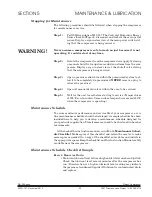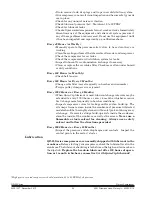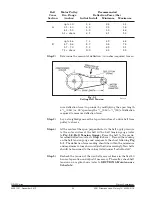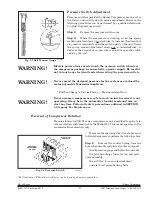
QR-25 Series
Quincy Compressor
52201-107, December 2012
17
3501 Wismann Lane, Quincy IL - 62305-3116
Pix 1160
Fig. 3-4 Checking Pressure Relief Valves
& Relieving System Pressure
Pix 1224
Fig. 3-3 Internal Drain Tube
30 PSIG
Follow ASME code for air receiver tanks and other pressure con-
taining vessels. Pressure vessels may not be modified, welded,
repaired, reworked or subjected to operating conditions outside
the nameplate ratings. Such actions will negate code status, affect
insurance status and may cause property damage, severe injury or
even death.
Always replace worn, cracked or damaged receivers. Do not use
plastic pipe (PVC) anywhere in a compressed air system. Serious
injury or death could result.
A drain valve must be located in the bottom of the air receiver to allow for
moisture drainage. Extend piping away from the unit to provide safe and con
venient removal of excess moisture. An auto matic drain valve is recommended.
If the air receiver is going to be subject to tempera
tures of 32°F or below, provisions must be made to guard
against freezing of the pressure relief valves, pressure
gauge, moisture drain and any moisture in the tank.
Condensation
Rust can form inside the crankcase and on internal
com ponents as a result of condensation. A compres
sor must operate long enough during each run cycle
to reach full operating temperature in order to reduce
the risk of condensation. Lubricant that appears milky
may have mixed with condensate. Failure to replace
contaminated lubricant will result in damage to
the compressor and may void warranty.
Condensation can also form in the air tank of your
com pressor. When this happens, a mixture of air and
mois ture will be expelled through the service valve
and into what ever is connected to the valve (e.g. air
hoses, metal air lines, pneumatic tools, spray guns). An
inline filter or dryer, available from your local Quincy
distributor, may be re quired to eliminate the moisture.
Condensation in the air tank can be kept to a mini
mum by draining the tank on a daily basis. This also
reduces the risk of rust developing and weak ening the
tank.
Manual Tank Drain Valve Operation
The manual tank drain valve on portable compressors
and some stationary compressors is located on the underside of the air tank.
Portable compressors can be tilted in the direction of the drain to allow re
moval of tank moisture.
Some tanks use an internal drain tube (Refer to Fig. 3-3, Internal Drain
Tube) to drain the moisture. Tank pressure is required to force moisture out
of the tank through the drain tube. Safe removal of tank moisture from the
WARNING !
WARNING !
Summary of Contents for QR-25 210
Page 42: ......















































